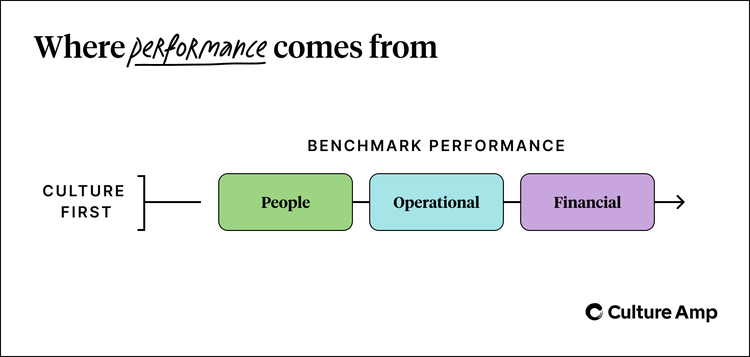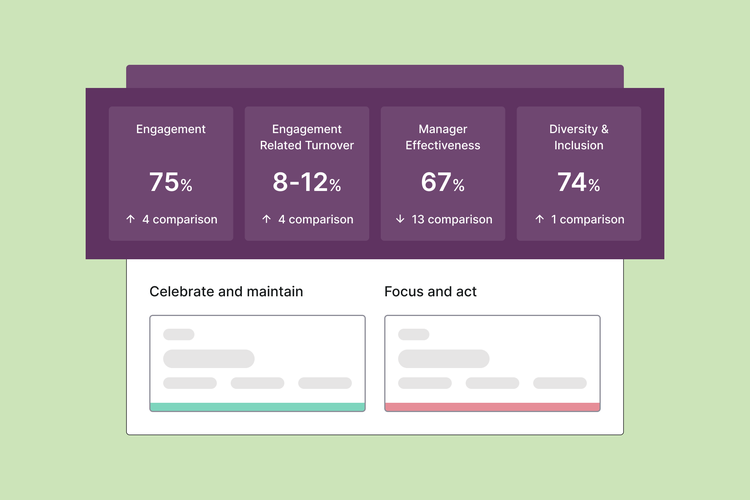
Harnessing data to create an engaging global employee experience

Written by

Senior Content Marketing Manager, Culture Amp
Creating a genuinely engaging employee experience is more important than ever in today's rapidly evolving workplace. This is especially true – and especially challenging – for global organizations that must ensure their efforts resonate with a diverse, distributed workforce.
In a recent webinar, Culture Amp’s Lead People Scientist, Erica Pachmann, sat down with Benchmark's Chief Human Resources Officer, Rhonda Buseman, to discuss how Benchmark, a global manufacturing company with 12,300 employees in 8 countries, uses its data to build an engaging and purposeful employee experience.
Below, we share key insights and takeaways from their conversation.
Employee engagement as a key business driver
At Benchmark, employee engagement is not just a buzzword – it’s a vital sign of the organization’s overall health. In fact, it is a key KPI. One of the five central pillars of Benchmark’s business strategy is “Delivering an engaging employee experience.”

Benchmark recognizes that employee engagement directly correlates with business success. As reflected in the image above, Benchmark believes that people performance leads to operational performance, which in turn leads to financial performance. Underpinning all of that is an inclusive, welcoming company culture where people want to be, work, and stay.
Rhonda explains:
“To build a long-term financially successful company, you have to focus on your people and what matters to people, what drives engagement, and their ability and willingness to give discretionary effort.”
Creating an engaging employee experience: Key learnings from Benchmark
Identifying areas of improvement and growing survey participation
While Benchmark now conducts regular engagement surveys to gather data on employee sentiment and overall workplace satisfaction, it was only in the fall of 2021 that the company launched its first global Engagement and Inclusion survey with Culture Amp.
This first survey revealed that communication was a key area of opportunity, with many respondents sharing that they didn’t feel the company did a good job communicating its long-term vision and strategy.
Based on these findings, Benchmark hired a Director of Internal Communications and launched an internal communications function – two actions that had a significant positive impact on survey results and participation rates.
Rhonda happily notes that survey participation rates have climbed more than 10% over the last three years, from 77% in Fall 2021 to 90% in Fall 2024. “It’s really remarkable for a manufacturing organization whose population is primarily frontline production workers who don’t have easy access to a computer.”
This increase in participation was at least partially driven by Benchmark’s internal marketing campaign, which their then-new Director of Internal Communications devised:
- To streamline access to the survey, Benchmark places posters around the factory floor with QR codes that allow employees to quickly scan and access the survey.
- In addition to email and digital communication, leaders promote the survey to their team members. For example, manufacturing supervisors wear buttons with QR codes linking to the survey.
Segmenting survey results to drive overall engagement and inclusivity
Recognizing the diverse makeup of its workforce, which spans multiple countries, Benchmark makes ample use of segmentation to pull deeper insights from its Engagement and Inclusion survey data. This allows them to note how specific groups are responding and take tailored, “surgical” action to improve engagement for those groups.

Rhonda especially appreciates Culture Amp’s built-in reporting function. Automatic dashboards make it effortless for Benchmark to identify and celebrate the wins of its top-scoring sites – and to pay special attention to any lower-scoring manufacturing sites that may need additional help or attention.
Segmentation has also enabled Benchmark to tailor their engagement initiatives to meet different employee groups' unique needs and expectations, ensuring a more personalized and engaging approach to employee experience.
Driving meaningful change with employee-centric action planning
At Benchmark, action planning consists of four main actions based on McKinsey and Company's Influence Model.
- Role modeling by leaders
- Explaining the necessity of change
- Implementing formal systems and tools
- Educating and training employees as needed
This model focuses on engaging employees in changing their mindsets and behaviors rather than just taking certain actions. Benchmark leaders address their employees’ underlying mindsets to drive effective change.
After each survey, Rhonda facilitates action-planning sessions with leaders to demonstrate how leaders can role model change, provide incentives, and offer training to support new, positive behaviors in the organization.
During these sessions, leaders work together to complete an Excel spreadsheet with action items, owners, and timelines. They also identify focus areas and align their actions with the influence model.
“This approach takes simple action planning much further and is much more thoughtful, and we think that it has had a great impact on our success,” shares Rhonda.
Taking a continuous approach to improving engagement
Engagement is a journey, and Benchmark is fully aware of the importance of evolving its approach to engagement to ensure relevance and momentum. The company’s goal is to elevate its initiatives rather than simply repeat past efforts. “We try to refresh and have something that looks and feels more elevated from the year before,” explains Rhonda.
By making an engaging employee experience a core business priority over the last 3 years, Benchmark was able to experience:
- An 8% increase in the percentage of employees who agree the company values diversity
- A 7% increase in the percentage of employees who agree that the company acknowledges and rewards outstanding service
- An 8% increase in the percentage of employees who agree that the company engages in open and honest communication
In addition, Benchmark’s engagement survey also led to the deployment of a purpose statement that addressed employees’ need to connect with one another and to understand the impact of their work. They initiated a global campaign involving all 12,000 of their employees and asked them to complete the statement, “We help make the world ___, ___, and ___.”
The winning statement? "We innovate for a healthier, safer, and better connected world to create a brighter future," highlighting the company's work in developing critical medical devices, military life-protecting devices, satellite technology, and 5G technology. This inclusive approach to defining the company's purpose was a significant achievement for Benchmark, setting a solid foundation for creating an engaging, people-first culture where employees understand the purpose of their work and are motivated to do their best.
As Benchmark continues to refine its efforts, its early successes demonstrate that putting people and culture first is not only the right thing to do as a human – but also the smart thing to do as a company.

Embed leadership accountability in taking action
Learn about Benchmark’s key focus areas, how the team secured leadership buy-in, and more.



